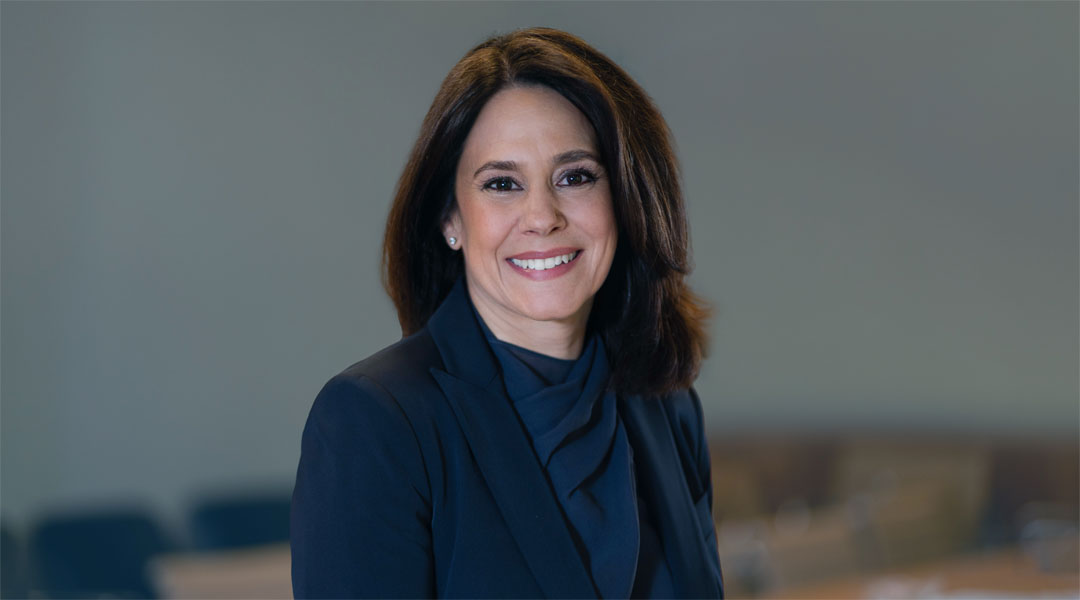
Dallas Fed, Latin American central banks explore financial stability risks
The COVID-19 pandemic, recent monetary tightening and a strengthening U.S. dollar have renewed attention to international financial stability risks. These themes were explored during a recent conference organized by the Federal Reserve Bank of Dallas and the Center for Latin American Monetary Studies (CEMLA) and held at CEMLA’s headquarters in Mexico City.
The program featured 12 papers with discussants and a keynote lecture by Victoria Ivashina, the Lovett-Learned Professor of Finance and head of the finance unit at the Harvard Business School.
Monetary policy transmission challenges
Central bank policy rates in most advanced economies were historically low (near zero) for many years following the Global Financial Crisis. This development spurred renewed interest in understanding barriers to monetary transmission through banking systems.
Glenn Schepens presented co-authored research (“The augmented balance-sheet channel of monetary policy”) on how bank balance sheets and funding costs interact with transmission of monetary policy rates to affect bank credit availability. The authors use credit registry data from Germany and Portugal to study the reaction to the European Central Bank’s policy rate cuts in mid–2014. The pass-through of the rate cuts to bank funding costs varied depending on the initial level of deposit rates, specifically their distance from zero. As rates approach zero—as was the case in Germany—bank financing constraints matter less for credit supply, and risk-taking is greater.
Andrew MacKinlay’s paper (joint with Michael Gelman and Itay Goldstein) “Monetary policy in the age of universal banking” finds that universal banks—those that combine wholesale, retail and investment banking units—reduce monetary policy efficacy. The notion is that as banks expand into a broader set of activities, earnings become more diversified and less sensitive to policy rates.
For instance, as the Federal Reserve raises its target range for the federal funds rate, more-stable bank earnings allow the institutions to maintain credit supply. Moreover, the authors also find that such a diversification effect appears to be asymmetric and pronounced during periods of monetary policy tightening.
Financial intermediation and the real economy
As recent experiences during the COVID-19 crisis showed, a reliable relationship with a bank or other financial intermediary is an asset for firms hit by financial or real shocks. The determinants of relationships, as well as the role of banks in the absorption or transmission of shocks, are of special interest in volatile times.
Sotirios Kokas presented his co-authored research “Shock absorbers and transmitters: the dual facets of bank specialization,” which explores whether bank-lending specialization may amplify industry-specific shocks. The authors study the question using U.S. syndicated loans and find that when a negative shock hits an industry, banks specializing in that sector tend to increase the flow of credit to it.
Moreover, specializing banks lend to more profitable firms in the affected sector (and obtain a higher loan yield). In turn, these banks reduce lending to unrelated industries, which then switch to other lenders. However, during periods with significant financing frictions, the authors suggest that industry-specific shocks could translate into negative aggregate real effects for unrelated industries.
Bernardus Van Doornik and his research team, using Brazilian data, investigate whether labor turnover affects bank risk and commercial loan performance. In “Labor Turnover and Bank Risk,” the authors find that banks with higher labor turnover show lower loan-loss reserves and higher loan growth, though with reduced profitability. The authors believe that the findings are consistent with labor turnover eroding banks’ institutional memory and soft information production that results in more transactional lending and short-termism.
Examining macroprudential policies
Since the Global Financial Crisis, jurisdictions around the world have implemented macroprudential polices. The most popular aim is to reduce household leverage by limiting mortgage borrowing.
Research by Kasper Roszbach and Gazi Kabas (“Household leverage and labor market outcomes: evidence from a macroprudential mortgage restriction”) looks at whether household leverage influences job search, labor market matching and wages. The authors use the introduction of a loan-to-value ratio mortgage restriction in Norway and the experience of workers who bought a house just before losing their jobs due to mass layoffs. They find reduced leverage associated with higher subsequent wages for these workers.
The intuition is that lower leverage enables workers to search longer, find jobs in higher-paying firms and move into new occupations and industries. The positive effect on wages is persistent and more pronounced for young and highly educated workers who are more likely to benefit from a longer job search. The results indicate that beyond reducing financial stability risks, policies limiting household leverage can improve workers’ labor market outcomes.
Mariela Dal Borgo presented her research with Stefano Colonnello (“Raising household leverage: evidence from co-financed mortgages”), which explores a program in Mexico that allows homebuyers to draw from mandatory retirement accounts to supplement their down payments. The authors find that the availability of such financing results in more mortgage lending and no increase in default risk. Moreover, the effects of the program are concentrated among credit-constrained borrowers at the lower end of the income distribution.
Financial stability implications of digitization
Technological change and financial innovation move simultaneously and often raise financial stability concerns. Two theoretical papers were presented seeking to add insight into risks associated with new technologies.
Kartik Anand presented “Cybersecurity and financial stability ” (joint with Chanelle Duley and Prasanna Gai) concerning incentives for financial institutions to invest in cybersecurity. A model behavior is outlined, featuring shared technology, which results in underinvestment in cybersecurity owing to free-riding behavior. However, coordination frictions underpinning bank runs alternatively act to spur investment in cybersecurity. On balance, the model suggests that systemwide cybersecurity is suboptimal and sensitive to rollover risk and bank heterogeneity. The authors conclude by offering several regulatory remedies to better align private and social incentives to invest in cybersecurity.
In “Stablecoins: adoption and fragility,” Christoph Bertsch explored digital private money that promises a stable and secure way for investors to park funds in the crypto universe. Like banks and money funds, stablecoin issuers face run risk that can only be met if the digital currency is backed by sufficiently liquid assets. The author finds that as a broader set of consumers adopt a stablecoin, the issuer becomes more cost efficient and experiences positive network externalities. However, since late adopters are less likely to have strong preference and trust in the stablecoin, they are more likely to run in the event of adverse information.
Climate-related financial risks
Central banks around the world have become increasingly attuned to climate change and its potential effects on financial stability.
Simon Xu presented “Environmental regulatory risks, firm pollution and mutual funds’ portfolio choices ,” which examined how U.S. mutual fund portfolio holdings respond to environmental regulations using county-level ozone nonattainment status as an exogenous source of variation in environmental regulation. He finds that mutual funds underweight heavy ozone-polluting stocks exposed to nonattainment designations, a finding reinforced by increases in environmental regulation intensity.
Christoph Herpfer discussed his co-authored work with Ricardo Correa, Ai He and Ugur Lel (“The rising tide lifts some interest rates: climate change, natural disasters and loan pricing”) that examined how climate-change-related natural disasters affect corporate borrowing costs. Following such disasters, interest rate spreads for U.S. syndicated loans involving at-risk but unaffected borrowers spike in both the primary and secondary markets. This effect is further amplified when attention to climate change is high. Borrowers with the most extreme exposure to climate change and those with the least ability to absorb adverse shocks sustain the highest increases in interest rate spreads.
Global role of the U.S. dollar
Victoria Nuguer presented her research with Eugenia Andreasen (“Capital flow management measures and dollarization”) on the effectiveness of macroprudential policies for smoothing local credit fluctuations due to foreign capital flows. In many dollarized emerging economies, foreign funding of the local banking system depends on international capital flows, and credit is granted in domestic and foreign currencies. The authors explore foreign currency reserve requirements in Peru intended to reduce the impact of capital flows on local credit cycles. They show that such requirements effectively damp capital inflow-induced credit booms. However, Peru’s policy largely operates through banks that have relatively fewer foreign currency reserves.
Robert Czech presented joint research exploring the “Dash for dollars” at the onset of the COVID-19 pandemic in early 2020. The authors use data on global bond holdings for U.K. financial institutions and find that U.S. dollar-denominated bonds experienced larger increases in spreads than did nondollar-denominated bonds. The authors, Ambrogio Cesa-Bianchi and Fernando Eguren-Martin, suggest that this is related to the special role of the dollar in global markets. Investors sold their dollar bonds first, but this resulted in a larger price impact. The authors also provide evidence that the selling of dollar-denominated bonds was tied to a need to meet immediate dollar obligations.
About the authors
The views expressed are those of the authors and should not be attributed to the Federal Reserve Bank of Dallas or the Federal Reserve System.


